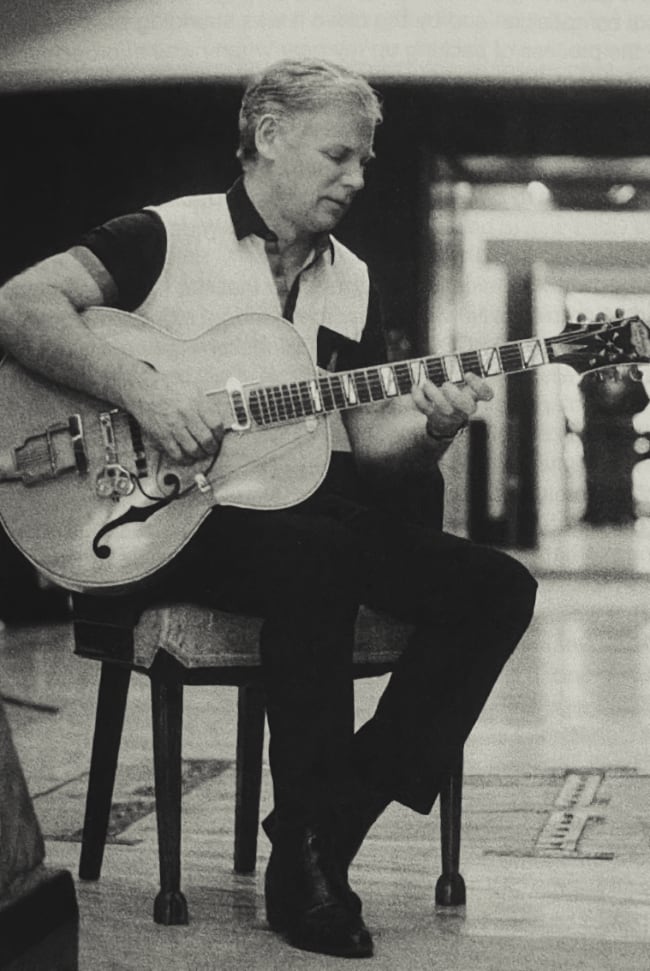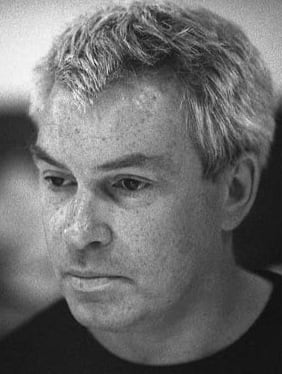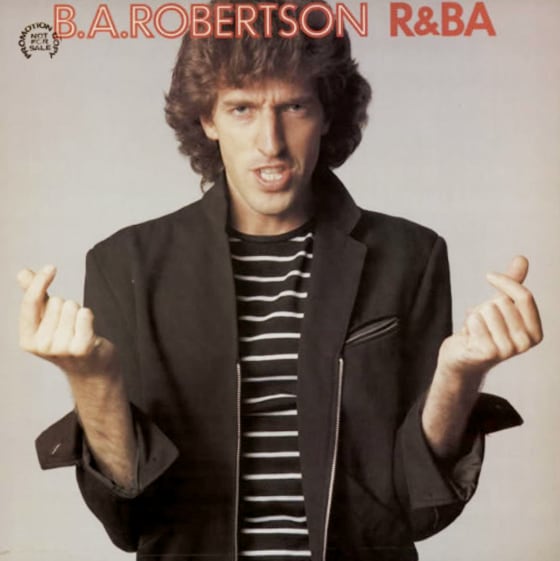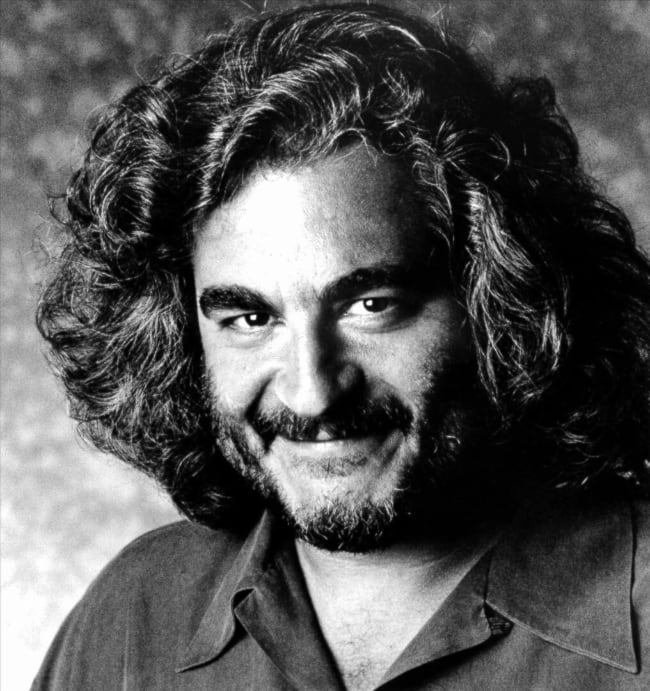Vamping With Clapton
22nd March 2022
Exclusive: Matthew Field and Ajay Chowdhury reveal the truth behind the Eric Clapton track
The file posted to SoundCloud last month purporting to be Eric Clapton’s apocryphal collaboration with Michael Kamen for the 16th James Bond film, 'Licence To Kill' has left fans split over its authenticity. However, we can confirm that the recording is indeed genuine. We first heard it in September 2020, the culmination of a fascinating journey unearthing the Holy Grail of lost Bond treasures which begun as COVID shut the world down.
Anybody who has read our book, 'Some Kind Of Hero: The Remarkable Story of the James Bond Films’, will know how intrigued we are by mysteries concerning 007. Clapton’s reported Bond demo with John Barry’s original James Bond Theme guitarist, Vic Flick was an enigma we wanted to solve.
The first clue of its existence emerged in June 1989 in the very first issue of the British movie magazine, ‘Empire’. Journalist Chris Heath had sat down with Michael Wilson and Barbara Broccoli in EON’s then South Audley Street HQ to quiz them on the decision making process when choosing an artist to record a Bond theme. Heath tantalisingly reported,
“The Eric Clapton story had particular mileage at one stage. Wilson suddenly looks a shade uncomfortable. ‘Oh yeah,’ he nods, ‘That didn’t work out.’ He hesitates, ‘I’ll tell you…I can’t really…um…I think what we’ve decided to do is forget it, not really to try to relive it in the press.’ He pauses for a friendly laugh. ‘I think we just don’t have any comment.’ Eventually he relents just a little bit. ‘I hate to be mysterious about it but when something doesn’t work out with a major artist…um…we brought together a lot of people and we tried to do something and they all worked really hard on it and we listened to the result and…um…we didn’t feel…we didn’t really break any new ground. Or whatever ground we did break was in the wrong direction. The trouble is it can be reported as us being unhappy with it but in the end everything a producer does – who he hires, the instructions he gives – is the producer’s fault.’ In this instance he says, it was the producer’s fault. ‘I can’t even say that Cubby shares the blame. I talked him into trying it. I have to take that one on the chin.’”
The next substantive mention of the track was in 2008, in ‘Vic Flick Guitarman: From James Bond to The Beatles and Beyond’ the autobiography of the famed guitarist. Flick was the first to give us a flavour of what the tune could have been, “Michael wanted to get back to the original sound for a low bass type riff and it was hoped that I could furnish it. The melody and other parts were to be laid on top of my low guitar riff.” He also recollects shooting a pop promo in the Docklands area of London. However, it is highly likely this has been mischaracterised and instead it was behind-the-scenes footage captured for promotional purposes.
The narrative was then taken up by Jon Burlingame, America’s leading journalist on the subject of music for films and television, in his indispensable book, ‘The Music Of James Bond’ first published in 2012. He reported lyrics had been written by Scottish songwriter and popstar, Brian Alexander (“BA”) Robertson.
After a creative renaissance with Timothy Dalton’s debut, 'The Living Daylights', John Barry was fully expected to return but ill-health prevented his involvement. The film music landscape was vastly changing in the 1980s and an album featuring several chart-topping contenders was becoming the norm in Hollywood. MGM/UA, trying to maximize revenue, felt the latest Bond soundtrack would benefit with the hiring of a specialist to package a commercial album to attract a younger audience.
Joel Sill was that expert. He had executive produced hit albums for ‘An Officer and a Gentleman’ (1982), ‘Flashdance’ (1983) and ‘Mannequin’ (1987) amongst others. For ‘Licence To Kill’, Sill was credited as music consultant on the film and executive soundtrack producer on the LP.
Our investigation began with the retired music executive, who told us from his home in Los Angeles; “Gordon Weaver whom I met at Paramount was working for the Broccolis in marketing. Gordon suggested they should bring me in to handle the music.” Sill was a self confessed Bond fan and admitted the job “was a dream come true.” With Oscar-winning songs and number one hits to his credit, Sill was an exciting choice to oversee Bond 16. His first task was to find a replacement for Barry and he immediately turned to his friend, Michael Kamen, “Michael had a serious record background, orchestrating contemporary rock music. He also knew Bond would be a big platform for him in terms of moving his career forward. He had the capabilities to do it. He was beginning to get some notoriety.”

ABOVE: JOel SILL
In 1989, Michael Kamen was the composer of the moment. He had established himself as a key orchestrator, working with rock musicians such as Pink Floyd, David Bowie, Aerosmith, Guns N’ Roses to name a few. He had orchestrated ‘Who Wants to Live Forever’, Queen’s cinematic song from the Sean Connery movie, ‘Highlander’ (1986). Kamen had contributed to Eurythmics’ 1984 hit, ‘Here Comes The Rain Again’. Recalled Sill, “Michael was wonderful in meetings. He was just smart, ingratiating and looked like a big bear. I had his agents and him put together a reel of his work and got it to Cubby, Michael and Barbara and they listened to it and said, ‘Yes, let’s meet with him.’”
Kamen’s rock credentials made him an apt choice and he relished the Bond project telling Burlingame, "If I wore a hat, I’d take it off [to Cubby]. The Broccoli crowd was very congenial and close. I grew to be friendly with Timothy Dalton.” The actor attended some scoring sessions.
It was only natural that he thought the theme song was his for the composing. And that is where one of the most intriguing Bond music stories begins. Singers had usually been the choice of the composer and EON, who had to consider the artistic appropriateness to the composition, as well as the potential success of the song in terms of sales, publicity and airplay. Another factor was the viability of the act who would need to reach a certain demographic to publicise the film in an uncatered for market.
Sill remembers, “Michael Kamen was friendly with Eric Clapton. In early discussions, he said, ‘What do you think about Eric coming in and working on a track?’ I said, ‘That would be absolutely fantastic!’ The original piece of music that Eric was going to do with Michael was actually for a commercial. Cubby had worked out an arrangement with a car company in America. They were going to pay to use the James Bond Theme and this was going to be one of the early tie-ins.”
Kamen had previously worked closely with the superstar guitarist on a number of projects including the critically acclaimed 1985 BBC TV mini-series, ‘Edge of Darkness’, directed by Martin Campbell. Future Bond editor, Stuart Baird, brought the duo to the attention of producer Joel Silver who hired them for his action movie, ‘Lethal Weapon’(1987).
Vic Flick speaking from his home in Las Vegas recalled Clapton telling him, “‘Michael Kamen and I have come up with this theme. It is an instrumental and we’d like you to be involved in it.’ It was all low guitar. Pop-y but dramatic.” The experience was somewhat of a reunion for Flick. He had met Clapton back in the 1960s during the John Barry Seven days at the New Musical Express concerts with other stars such as Cliff Richard and Adam Faith.

Above: Vic Flick performing for 'Licence To Kill'
Sill suggested we speak to the music editor on ‘Licence To Kill’, director John Glen’s son, Andrew. Today Glen is hugely in demand and describes his role as, “the conduit between the composer and the director.” Andrew remembers the initial idea for the project was actually far more elaborate, “It wasn’t only Eric, it was going to be a stream of top guitar heroes, if you like, all coming together and all contributing to this re-imagining of the Bond theme. Kamen was incredibly enthusiastic, he was very, very popular and well connected. He knew everyone and everyone loved Michael. It was absolutely believable that he could assemble this team of top guitarists. When I turned up at the session I half expected, certainly, David Gilmour. I can’t remember the specific names but it was of the likes of Jimmy Page, Jeff Beck.”
The story behind Clapton’s Bond track unravelled further when Glen put us in touch with Kamen’s trusted engineer, Steve McLaughlin. At first McLaughlin’s reaction was “this was a very, very long time ago and a lot of water and various other things have flown under the bridge.” But he soon opened up, “It was a big rocky sort of number, parts of it was based on the Bond theme but not really. It wasn’t a version of the Bond theme. It was a soaring guitar solo-led thing and it alluded to the Bond theme.”

Above: Andrew Glen

Andrew Glen’s recollection of the music was, “Vic Flick playing the Bond theme that we know and love. And then the music would change completely and go into a blues-y improvisation by Eric. And then back to the Bond theme and back to a blues-y improvisation by Eric.”
McLaughlin’s memories are rueful, “I’d been away in Barbados for a couple of weeks. I think Michael was there too. I’d come back the day before we started recording. I’d brought, unfortunately, a big bottle of Barbadian rum and we went out with all my friends. We all got completely caned. Woke up with an appalling hangover. The next morning I had to go to the East End to the Docklands where a guy had set up a studio in an apartment that was mostly made of glass. It had two drum kits in it and there was Olle Romö from the Eurythmics and Steve Ferrone the drummer with Clapton doing a double drum thing all out in the open. With just headphones to monitor the session on - two drummers at once with a massive hangover in a glass room - is the seventh circle of hell. That’s how we began the Clapton theme.”
The guitar section was recorded at the now-defunct Townhouse 3 Studios near Battersea Power Station. Andrew Glen, expecting an all-star line-up, was underwhelmed, “In the end it was Vic Flick and Eric. I remember being slightly disappointed and thinking ‘Oooh, what happened there?’” McLaughlin, however, felt, “a great sense of anticipation. I talked to Vic about what equipment he was bringing. Vic was keen to bring his new amp and his much better Fender Strat. I had to be very polite – ‘Make sure you bring the guitar and the amp you recorded the original James Bond Theme on and he said, ‘Well if you want that old thing, sure.’” Flick had the original guitar, foot pedal and guitar cord but did not have the old Vox amplifier which had fallen off of a stage and smashed many years earlier.
Sill was chagrined, “Michael showed up completely unprepared. He didn’t have a note of music written. Eric said, ‘What are we going to do?’ And Michael said, ‘Well we’re going to do a demo for this commercial.’ Michael was so capable; he was actually over talented in the sense it made him overconfident. He showed up to make a record. They were going to ad lib and put it together in the studio and it didn’t work. They were just playing around with different versions. They didn’t have anything structured. It didn’t really identify that it was Eric. They didn’t really distil it well enough to make it anything that was memorable. And I’m such a Clapton fan.” The session was memorable for Sill for another reason, “While we were in the Townhouse, Freddie Mercury was in the next studio and he came in.”

Above: Freddy Mercury with Michael Kamen
McLaughlin concedes he was not around for pre-production but opines, “I don’t mean to contradict Joel but I don’t think Michael would have gone into the studio with Eric, who he loved and respected, without an idea of what music he was going to play. Michael was great at inventing music on the fly, and often relied on his skill at that. However a year or two after these sessions he and Eric performed a guitar concerto at the Albert Hall, where every note was written out and meticulously rehearsed."
During this period, producer Russ Titelman was at Townhouse working with Clapton on his album ‘Journeyman’. Sill remembers the Grammy award winner being at the Bond session. Titelman did not recall the record specifically but when we played him the YouTube link he was confident, “Listening to it now, it’s obvious to me that it is Steve Ferrone playing drums and it’s definitely Eric Clapton playing the guitar.”
Steve Ferrone, a sought-after session drummer, who had worked with Kamen for many years admitted, “Anything involving James Bond is exciting for me. I've always been a big James Bond fan.” Speaking to us by telephone from America, Ferrone reveals he was star-struck by Vic Flick, “He walked in with that guitar…that was a big thrill for me. Talk about something being consistent through the Bond movies - that sound.” He remembered playing with second drummer, Olle Romö but recalled, “Eric may have overdubbed. I don't really remember us playing together. We had the rhythm track. I think Eric did his thing after with Michael.” Ferrone had not heard the track until we played it for him nearly 30 years afterwards, “I’m very proud of it. Listening to it, that Bond thing always had that swagger to it. I listen for the groove. It always had this cocksuredness swing to it. You just have to go there with it. There's no other place to put it.”

Above: Steve Ferrone performing.
The attempt was, according to Sill, the end of Clapton’s involvement. “The idea was if it worked for the car commercial, we planned on possibly using it and potentially more new Clapton instrumental work throughout the score of the film. But once the Clapton piece fell apart for the commercial, there was no chance it was going to go into the movie. Michael had other hopes. But from my point of view, this was never going to be the main or end title song for ‘Licence To Kill’, or ‘Licence Revoked’ as it was originally known. The sessions shook the confidence of the producers. But Michael obviously redeemed himself with a wonderful score.” Vic Flick, “was so disappointed it wasn’t used.”
Heath’s Empire article quoted Michael Wilson further;
“To the extent that people submit material and it is listened to accepted or rejected I don’t think it is appropriate for our company to comment, because it will hurt the things that get submitted to us if we were to confirm and deny every story. People will be reluctant to send stuff in if they hear that if they’re rejected, they’re going to be reading about it in the newspapers. So, I feel it’s inappropriate to discuss Eric Clapton.”
The producer outlined why, to this day, most Bond song submissions or commissions have the element of plausible deniability about them. Wilson’s comments in 1989 also explain why, despite the fact that one of the world’s greatest rock artists had recorded a Bond track, it has remained undiscovered for over 30 years. It made us even more eager to find out if the recording still existed.
McLaughlin speculated that the recording was buried, “because if it wasn’t going to make it as the end credit song, it didn’t seem worth finishing.” Sill remembers, “It was heart-breaking to me. The problem was not with Eric but with his manager, Roger Forrester. Roger could be a difficult guy to deal with. He did a great job for Eric but he was a street guy. He wanted Eric to be paid for the whole film. I didn’t feel that was fair. I was happy to pay him for his work in relation to what we had agreed on for the car commercial, which never materialised.” The American car company Sterling Motors would eventually release a commercial featuring a completely separate version of the James Bond Theme.
Kamen had intended to compose a title song for the picture. According to Sill, this music was unconnected to the Clapton demo: “This is where the BA Robertson connection arises. BA had worked with Mike Rutherford [part of the band Genesis and lead of Mike & The Mechanics]. BA wanted to write the song. Michael wanted BA to have the song.” We later enquired with Robertson who admitted via email, “I did try to write a song with Michael Kamen, and it would have fallen into Joel’s bailiwick. I did go to Michael’s house in Notting Hill - it pre-dates this movie. When this movie is in production, [I’d] joined up with Hit & Run, (the Genesis office). I get a call from an executive at BMI, to ask if Mike & The Mechanics, would be interested in a Bond title song. The M&M’s connection didn’t happen.”

Above: BA Robertson'S Final Studio album, released 1982
Sill elaborates further, “I didn’t think Michael had a theme in the film that would convert to a great song. Michael put some themes together but it just wasn’t a song theme. For me.” The rejection strained Sill’s relationship with Kamen, “There was a lot of resentment. Michael was very angry. He fought to get his song in there. We spoke a lot, we were close friends. It wasn’t easy but you tell the truth. Then he went to his agent, who was also mine, Sam Schwartz. Sam came to me and said, ‘Why can’t you work with Michael to get a theme out of this?’ I said, ‘Because it’s not good enough. If there was a way to do it, believe me I would.’ It caused friction for a while. My responsibility, I felt, was always to the film. No matter what I was working on, it was to the film first, then to the soundtrack.”
Vic Flick did return to record the James Bond Theme for the ‘Licence To Kill’ score at CTS Studios. McLaughlin insisted, “We should have the original with the orchestra. Vic came in with his round backed guitar and the orchestra loved it.”
Sill searched boxes of tapes looking for the long lost demo and made enquiries on our behalf. So did Andrew Glen. Kamen had passed away in 2003. Then one Saturday morning, in September 2020, Steve McLaughlin demanded we jump on Zoom as quickly as possible. Without saying anything he streamed a file to us named: “Bond Theme (1989)”. Having followed the story for 30 years, it was an incredible surprise to finally hear it, but also, to know, it had survived. We listened with intent excitement to this melodic, track which added yet another layer to the complex history of Monty Norman’s James Bond Theme. If finished, this would have added a unique flavour to the film.

Above: Michael Kamen
So how did the mythic track finally surface? Our conversation with McLaughlin had triggered a curiosity of his own. He remains close to the Kamen family and he called Michael’s daughter Zoe and sent her deep into her late father’s archive where she discovered the missing music. However, the file that leaked online came via the Clapton fan community from a Japanese bootleg CD. The track was reportedly sourced from a cassette tape secured by a former Townhouse employee who passed it to a Clapton fan who then shared it with a contact in Japan before it fell into the hands of bootleggers.
We sent a draft of this article to Eric Clapton’s business manager, Michael Eaton, who said he found it an interesting read. He forwarded our enquiry to Clapton who disappointingly declined to participate or comment.

Above: Eric Clapton
So much has changed in the musical world of 007 since 1989. We are now used to contemporary versions of the James Bond Theme used outside of the film score for promotional purposes: Moby and Paul Oakenfold’s versions spring to mind. The Clapton piece, like the movie, attempted to position the picture to the North American market and similarly tried to push creative boundaries. It was apt that when recorded, Dalton’s sophomore Bond had been titled ‘Licence Revoked’. This unfinished melodic, bluesy rocker was perhaps, like the movie, ahead of its time. With a new 60th anniversary documentary on Bond music currently in production by ‘Everything Or Nothing’ producer, John Battsek and director Mat Whitecross, hopefully, this James Bond rarity might officially be released.
Copyright © SKOH Limited.








